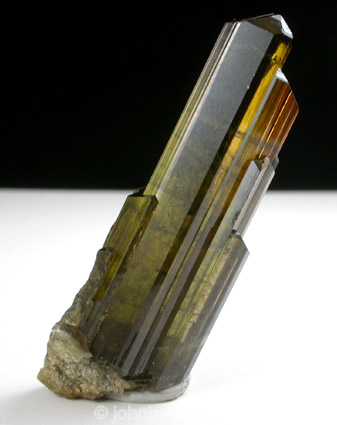The Mineral clinozoisite

Clinozoisite is the same as Zoisite but crystallizes in the monoclinic system, which scientifically classifies it as an individual mineral species. Clinozoisite is also almost identical in composition to Epidote but lacks significant iron in its structure. It forms a series with Epidote, and in many cases the actual distinction between these two minerals cannot be made. In fact, some specimens from certain localities are labeled as Clinozoisite-Epidote since they are intermediary between these two minerals without an exact determination.
Clinozoisite is named after its monoclinic crystal habit and the reference to its polymorph Zoisite.
Chemical Formula
Ca2Al3(SiO4)3(OH)
Color
Brown, brownish-green, olive-green, greenish yellow, dark yellow, gray, beige. Rarely pink or white.
Crystal System
Monoclinic
Properties
Streak
White |
Hardness
7 |
Transparency
Transparent to translucent |
Specific Gravity
3.2 - 3.4 |
Luster
Vitreous |
Cleavage
1,1 |
Fracture
Uneven |
Tenacity
Brittle |
Varieties
-
Rare, strontium-rich member of Clinozoisite with one of the calcium atoms replaced by strontium. It is named after the type locality of Niigata Prefecture, Japan, and is scientifically categorized as an individual mineral species. Niigataite was renamed to Clinozoisite-(Sr) by the IMA in 2006.
Uses
Most forms of Clinozoisite are ugly and do not have much use. The rare transparent forms, especially from Pakistan, make a valuable collectors mineral.
Noteworthy Localities
The best examples of this mineral are from Pakistan in gemmy brown elongated crystals, found in the Tormiq valley and Shigar Valley (Alchuri) in Skardu. Dense olive-green fans and interconnected spikes of Clinozoisite crystals come from the Los Serranos Quarry, Albatera, Spain. Small pink crystals come from the Val D'Ossola, Piedmont, Italy; and stubby golden brown crystals from the Quiruvilca Mine, La Libertad, Peru. Large Clinozoisite crystals came from Real del Castillo, near Ensenada, Baja California Norte, Mexico; and small acicular pink crystal groupings from Alamos, Sonora, Mexico.
In the U.S., the vast majority of Clinozoisite localities are in the Northeast. Good crystals come from Sanford, York Co., Maine; and Joppa Hill, Amherst, Hillsborough Co., New Hampshire. Exceptional transparent crystals come from the Belvidere Mountain quarries, Lowell/Eden, Orleans & Lamoille Cos., Vermont. Other important Clinozoisite localities are Chester, Hampden Co., Massachusetts; Old Mine Plaza, Trumbull, Fairfield Co., Connecticut; West Redding, Fairfield Co., Connecticut; and the Hunting Hill quarry, Rockville, Montgomery Co., Maryland. Large, well-developed crystals came from the Keystone Quarry, Cornog, Chester Co., Pennsylvania; and the pink variety from Spruce Pine, Mitchell Co., North Carolina (where it is often confused with the Thulite variety of Zoisite).
Distingushing Similar Minerals
Epidote - Usually greener in color and slightly higher specific gravity; otherwise difficult to distinguish.
Torumaline - Lacks perfect cleavage.
The pink Clinothulite variety is often confused with the Thulite variety of Zoisite.